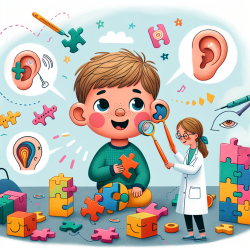Children with cleft palate face numerous challenges, one of which is a higher likelihood of developing Spatial Processing Disorder (SPD). SPD manifests as difficulty understanding speech in noisy environments, despite normal hearing test results. Given that the prevalence and duration of otitis media (middle ear infections) are significantly higher in children with cleft palate, this study aimed to determine the prevalence of SPD in this vulnerable population and explore possible interventions.
Understanding Spatial Processing Disorder
SPD is a type of Central Auditory Processing Disorder where individuals struggle to focus on speech sounds in noisy settings. This difficulty is particularly impactful for school-aged children, who often find themselves in noisy classroom environments. Recently, the Listening in Spatialized Noise-Sentences (LiSN-S) test was developed to diagnose SPD. This test measures the ability to use spatial cues to differentiate a target talker from competing talkers, providing a robust tool for identifying SPD.
The Link Between Otitis Media and SPD
Research has shown that children with a history of otitis media are at a higher risk of developing SPD. Otitis media is common among children with cleft palate, with a prevalence rate of 97% by the age of 2, compared to 60% in the general population. This high prevalence suggests that children with cleft palate may be particularly susceptible to SPD.
Study Methodology
To explore the prevalence of SPD in children with cleft palate, we recruited participants aged 6 to 16 years from a cleft palate clinic. Participants underwent the LiSN-S test, which involves four conditions varying in terms of the virtual location of the noise source and the vocal quality of the speaker. SPD was diagnosed if the spatial advantage score was equal to or greater than 2 standard deviations below the North American mean.
Key Findings
The study revealed that 40% of the children with cleft palate had SPD. Additionally, four other children had significant losses in speech intelligibility in noisy environments, even though they did not meet the formal diagnostic criteria for SPD. This finding underscores the importance of early identification and intervention for children with cleft palate.
Intervention and Improvement
Three children diagnosed with SPD underwent remediation using the Listening in Spatialized Noise & Learning (LiSN & Learn) program. This program involves auditory training games designed to improve spatial processing abilities. All three children showed substantial improvement, highlighting the potential for remediation to enhance the learning experience for children with SPD.
Implications for Practice
Given the high prevalence of SPD in children with cleft palate, it is crucial for speech-language pathologists and other healthcare providers to be vigilant in identifying and addressing this disorder. Early intervention can significantly improve a child's ability to understand speech in noisy environments, thereby enhancing their academic performance and overall quality of life.
Conclusion
Spatial Processing Disorder is highly prevalent in children with cleft palate, but with proper identification and intervention, these children can overcome significant barriers to their communication and learning. The LiSN-S test and the LiSN & Learn program offer valuable tools for diagnosing and treating SPD, providing a pathway to better outcomes for affected children.
To read the original research paper, please follow this link: Canadian Journal of Speech-Language Pathology and Audiology.










